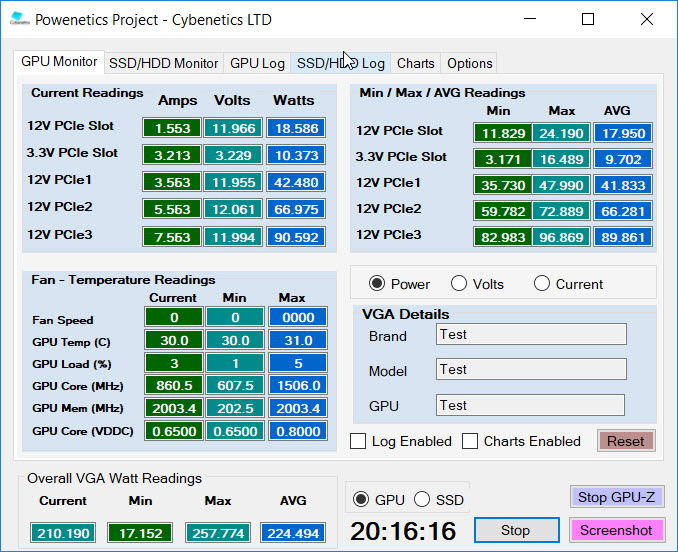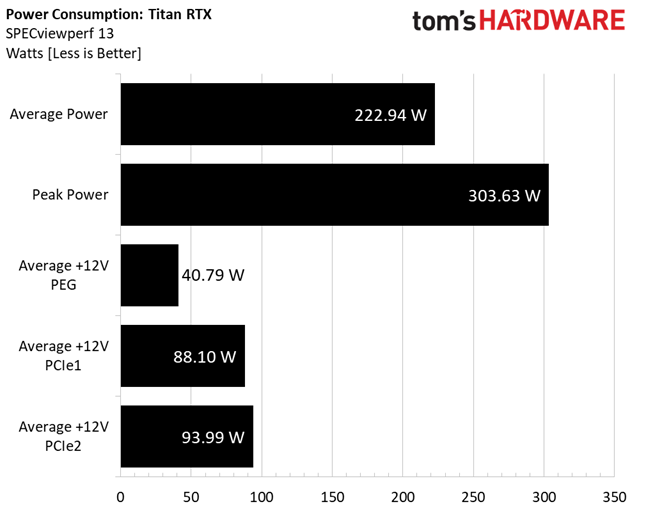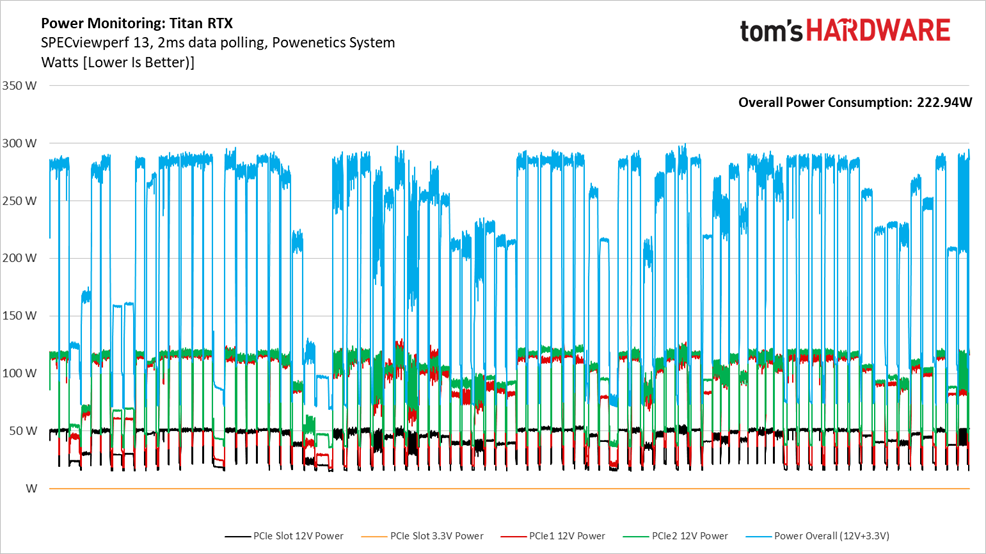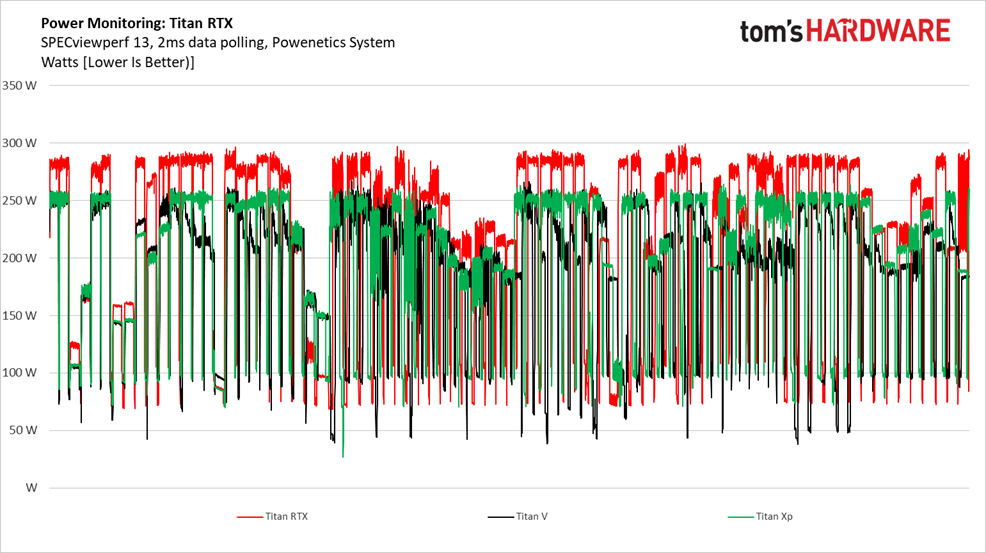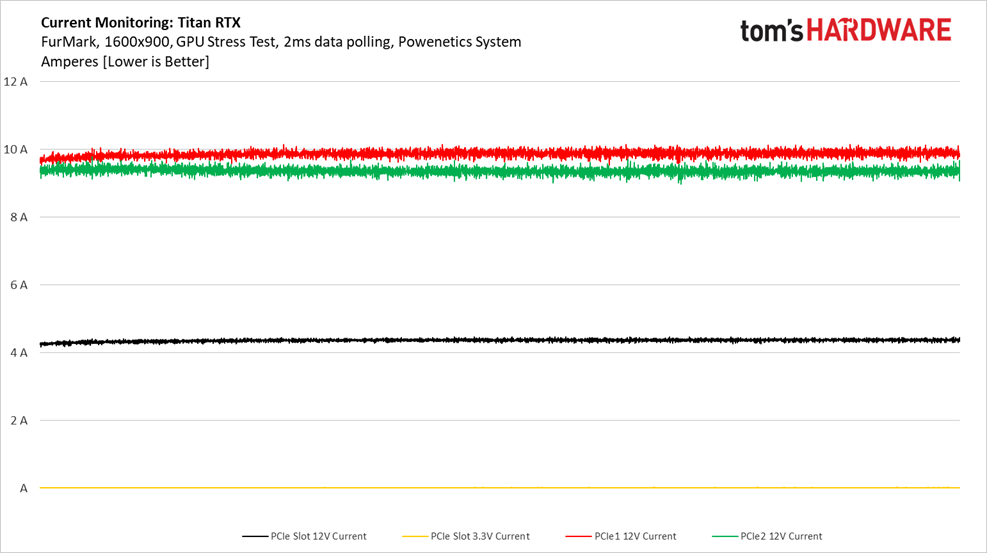Nvidia Titan RTX Review: Gaming, Training, Inferencing, Pro Viz, Oh My!
Why you can trust Tom's Hardware
Power Consumption
Slowly but surely, we’re spinning up multiple Tom’s Hardware labs with Cybenetics’ Powenetics hardware/software solution for accurately measuring power consumption.
Powenetics, In Depth
For a closer look at our U.S. lab’s power consumption measurement platform, check out Powenetics: A Better Way To Measure Power Draw for CPUs, GPUs & Storage.
In brief, Powenetics utilizes Tinkerforge Master Bricks, to which Voltage/Current bricklets are attached. The bricklets are installed between the load and power supply, and they monitor consumption through each of the modified PSU’s auxiliary power connectors and through the PCIe slot by way of a PCIe riser. Custom software logs the readings, allowing us to dial in a sampling rate, pull that data into Excel, and very accurately chart everything from average power across a benchmark run to instantaneous spikes.
The software is set up to log the power consumption of graphics cards, storage devices, and CPUs. However, we’re only using the bricklets relevant to graphics card testing. Nvidia's Titan RTX gets all of its power from the PCIe slot and a pair of eight-pin PCIe connectors. Should future Turing-based boards need three auxiliary power connectors, we can support them, too.
SPECviewperf 13
Rather than running Titan RTX through a gaming workload to measure real-world power consumption, we recorded the entirety of SPECviewperf 13.
An average of 223W across SPECviewperf 13 tells us that Titan RTX doesn’t sustain high power use through the professional datasets. However, a spike above 300W, almost 24W higher than Nvidia’s TDP, shows how a frenetic workload can sometimes lead to peaks that exceed specified limits.
Get Tom's Hardware's best news and in-depth reviews, straight to your inbox.
More demanding tasks tend to push harder against the card’s ceiling, resulting in a consistently higher average but less dramatic spikes.
Nvidia does a good job of balancing Titan RTX’s power draw between two eight-pin auxiliary connectors and the PCIe slot.
The blue overall power consumption line, representing the sum of all other lines, mostly obeys Nvidia’s 280W limit.
This is our favorite power consumption chart. It shows how Titan RTX leans on its higher power budget as it serves up more performance than Titan V and Titan Xp. Any discussion of efficiency must take into account that both variables increase.
Although this chart is busy, zeroing in on the black line tells us that current over the PCIe slot barely exceeds 4A. That’s well below the PCI-SIG’s 5.5A maximum.
FurMark
Hammering Titan RTX with FurMark has a big effect on average power consumption, which rises to almost 286W. Peak power use is about 10W lower than what we observed during the SPECviewperf 13 run, though.
The much more consistent workload makes it easier to compare draw over each rail. Again, Nvidia achieves good balance between its two eight-pin auxiliary connectors, while the PCIe slot averages 52W.
Titan Xp was a 250W graphics card sporting Nvidia’s 12 billion-transistor GP102 processor. The company’s reference cooler with its centrifugal fan was good enough to maintain performance, even under the demands of FurMark.
Titan V utilized the same style of cooler. However, the same 250W power limit didn’t give a much more sophisticated 21.1 billion-transistor GV100 processor much room to stretch its legs. As a result, under FurMark, we see power consumption dip as voltage and frequency are throttled back. We’ll see in our thermal measurements on the next page that Titan V simply gets too hot.
For Titan RTX, Nvidia switched to dual axial fans recirculating waste heat back into your case. So long as you ensure ample ventilation, though, that vapor chamber-based cooler keeps up with the 280W+ board.
Current draw over the PCIe slot hovers between 4A and 5A, leaving plenty of headroom under the 5.5A ceiling.
MORE: Best Graphics Cards
MORE: Desktop GPU Performance Hierarchy Table
MORE: All Graphics Content
Current page: Power Consumption
Prev Page Performance Results: Gaming at 3840 x 2160 Next Page Temperatures and Fan Speeds-
AgentLozen This is a horrible video card for gaming at this price point but when you paint this card in the light of workstation graphics, the price starts to become more understandable.Reply
Nvidia should have given this a Quadro designation so that there is no confusion what this thing is meant for. -
bloodroses Reply21719532 said:This is a horrible video card for gaming at this price point but when you paint this card in the light of workstation graphics, the price starts to become more understandable.
Nvidia should have given this a Quadro designation so that there is no confusion what this thing is meant for.
True, but the 'Titan' designation was more so designated for super computing, not gaming. They just happen to game well. Quadro is designed for CAD uses, with ECC VRAM and driver support being the big difference over a Titan. There is quite a bit of crossover that does happen each generation though, to where you can sometimes 'hack' a Quadro driver onto a Titan
https://www.reddit.com/r/nvidia/comments/a2vxb9/differences_between_the_titan_rtx_and_quadro_rtx/ -
madks Is it possible to put more training benchmarks? Especially for Recurrent Neural Networks (RNN). There are many forecasting models for weather, stock market etc. And they usually fit in less than 4GB of vram.Reply
Inference is less important, because a model could be deployed on a machine without a GPU or even an embedded device. -
mdd1963 Reply21720515 said:Just buy it!!!
Would not buy it at half of it's cost either, so...
:)
The Tom's summary sounds like Nviidia payed for their trip to Bangkok and gave them 4 cards to review....plus gave $4k 'expense money' :)
-
alextheblue So the Titan RTX has roughly half the FP64 performance of the Vega VII. The same Vega VII that Tom's had a news article (that was NEVER CORRECTED) that bashed it for "shipping without double precision" and then later erroneously listed the FP64 rate at half the actual rate? Nice to know.Reply
https://www.tomshardware.com/news/amd-radeon-vii-double-precision-disabled,38437.html
There's a link to the bad news article, for posterity.
